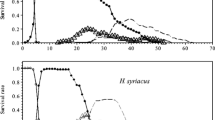Summary
Observations have been made and experiments performed to investigate the colour of pupae inPapilio machaon L. andPieris brassicae L.
InP. machaon brown pupae are nearly always formed except when the pupation site is the foodplant, when nearly half the pupae are green. Switching experiments showed that the sensitive period was just before pupation and that the colour and texture of round foodplant stalks had a significant influence in producing green pupae.
In the Cambridge stock ofP. brassicae used all non-diapause pupae are “brown” (including yellowish, ochreous, greyish forms), all diapausing pupae green. The background on which pupation occurred had no significance, nor did the photoperiod immediately preceeding pupation.
The colour could, however, be changed by the food used; on artificial diet the pupae are blue or turquoise. This effect could not be reversed by the addition ofβ-carotene to the diet, as might be expected. Attention is also drawn to the fact that at least one pupal colour is known to be genetic, and the possibility that the green/brown relationship with diapause in the CambridgeP. brassicae stock may be due to the rearing conditions used.
Similar content being viewed by others
References
Angersbach, D., Kayser, H.: Wavelength dependence of light-controlled pupal pigmentation. Naturwissenschaften58, 571 (1971)
Buckler, W.: The larvae of the British butterflies and moths. Ray. Soc. Lond.1 (1886)
Bückmann, D.: Melanisierungsverlauf und Melanisierungshemmung bei der KohlweißlingspuppePieris brassicae L. Wilhelm Roux' Archiv166, 236–253 (1971)
Cribb, P.W.: Colour forms of the pupae of the swallowtail butterfly (Papilio machaon, Linn.). Bull. amat. ent. Soc.29, 105–106 (1970).
Danilevskii, A. S.: Photoperiodism and seasonal development of insects. Edinburgh: Oliver & Boyd 1965
David, W.A.L., Gardiner, B. O. C.: RearingPieris brassicae (L.) on semisynthetic diets with and without cabbage. Bull. ent. Res.56, 581–593 (1966)
Frohawk, F. W.: The complete book of British butterflies. 384 pp. London: Ward, Lock & Co. 1934
Gardiner, B. O. C.: Genetic and environmental variation inPieris brassicae. J. Res. Lepid.2, 127–136 (1963)
Hidaka, T.: Recherches sur le determinism hormonal de la coloration pupale chez lépidoptères. I. Les effêts de la ligature, de l'ablation des ganglions et de l'incision des nerfs chez prépupes et larves âgrées de quelques papilionides. Annot. zool. jap.24, 69–74 (1956)
Hidaka, T.: Mise en évidence de l'activité sécrétoire du ganglion prothoracique dans l'adaptation chromatique de la nymphe duPapilio xuthus L. C.R. Soc. Biol. (Paris)154, 1682–1685 (1960)
Kayser, H.: Die rolle der carotinoide und des gallenfarbstoffs bei der farbmodifikation der puppen vonPieris brassicae. J. Insect Physiol.20, 89–103 (1973)
Merrifield, F., Poulton, E. B.: The colour-relation between the pupae ofPapilio machaon, Pieris rapae and many other species, and the surroundings of the larvae preparing to pupate etc. Trans. ent. Soc. Lond. 369–433 (1899)
Moss, J. E.: The natural control of the cabbage caterpillarsPieris spp. J. anim. Ecol.2, 210–231 (1933)
Ohtaki, T.: Humoral control of pupal coloration in the cabbage white butterflyPieris rapae crucivora. Annot. zool. jap.33, 97–103 (1960)
Ohtaki, T.: Further studies in the development of pupal coloration in the cabbage white butterflyPieris rapae crucivora Annot. zool. jap.36, 78–82 (1963)
Ohtaki, T., Ohnishi, E.: Pigments in the pupal integuments of two colour types of cabbage white butterflyPieris rapae crucivora. J. Insect Physiol.13, 1565–1574 (1967)
Oltmer, A.: Die Steuerung des Melanineinbaus in des Farbmuster der KohlweißlingspuppePieris brassicae L. Wilhelm Roux' Archiv160, 401–427 (1968)
Poulton, E. B.: An enquiry into the cause and extent of a special colour-relation between certain exposed Lepidopterous pupae and the surfaces which immediately surround them. Phil. Trans. B178, 311–441 (1887)
Rothschild, M., Valadon, G., Mummery, R., Gardiner, B. O. C.: Storage of carotenoids in diapausing pupae ofPieris brassicae L. andP. napi L. and their influence on larval colouration (Lep. Pieridae). In preparation
Rüdiger, W., Klose, W., Vuillaume, M., Barbier, M.: On the structure of pterobilin, the blue pigment ofPieris brassicae. Experientia (Basel)24, 1000 (1968)
Van der Geest, L.P. S.: Effects of diets on the haemolymph proteins of larvae ofPieris brassicae. J. Insect. Physiol.14, 537–542 (1968)
Verity, R.: Rhopalocera Palaearctica. Roger Verity. Florence (1905)
Wiklund, C.: Pupal coloration inPapilio machaon in response to the wavelength of light. Naturwissenschaften59, 219 (1972)
Yin, C.-M., Chippendale, G. M.: Juvenile hormone regulation of the larval diapause of the Southwestern corn borerDiatraea grandiosella J. Insect Physiol.19, 2403–2420 (1973)
Author information
Authors and Affiliations
Rights and permissions
About this article
Cite this article
Gardiner, B.O.C. Observations on green pupae in Papilio machaon L. and Pieris brassicae L.. W. Roux' Archiv f. Entwicklungsmechanik 176, 13–22 (1974). https://doi.org/10.1007/BF00577829
Received:
Issue Date:
DOI: https://doi.org/10.1007/BF00577829




